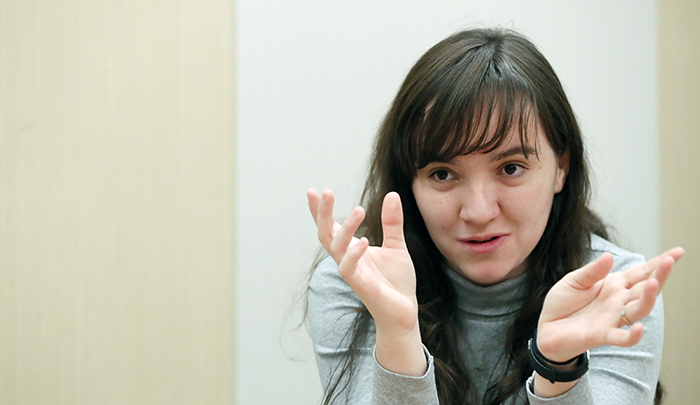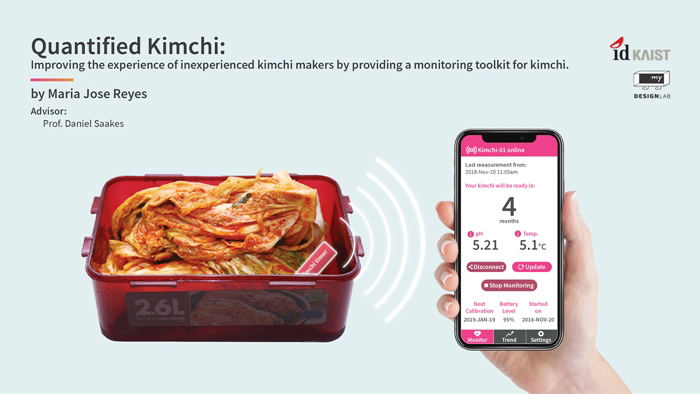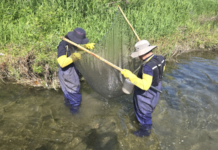
Maria Jose Reyes, a Costa Rican graduate student who developed a kimchi timer while earning her master’s at the Korea Advanced Institute of Science and Technology (KAIST), on Feb. 26 describes her invention at Korea.net’s Seoul office. (Jeon Han)
By Xu Aiying, Song Baleun and Lee Hana
Seoul | Feb. 26, 2019
Maria Jose Reyes, a 25-year-old Costa Rican who just finished graduate school in Korea, has developed a unique device used in the kimchi-making process.
Dubbed the “kimchi timer,” the core technology of this device lies in its smart sensor and mobile app. To test it out, one first needs kimchi, which involves stuffing the pepper flakes into the folds of a salted cabbage.
When this is done, the sensor is inserted inside the kimchi container and connected to the app. Setting the timer to the preferred level of fermentation allows monitoring of the kimchi until it is ready to serve. The app even charts changes in the pH level as the kimchi is fermenting.
Reyes received her master’s in industrial design on Feb. 15 at the Korea Advanced Institute of Science and Technology (KAIST), with her thesis titled “Quantified Kimchi: Improving the Experience of Novice Kimchi Makers by Providing a Monitoring Toolkit.”
“By adding technology to kimchi’s natural fermentation process, I wanted to make the production of good kimchi easier for other non-Koreans like myself,” she said in explaining the motivation behind her study.
The following are excerpts from Korea.net’s interview with the inventor on Feb. 26.

“Quantified Kimchi: Improving the Experience of Novice Kimchi Makers by Providing a Monitoring Toolkit” is the thesis of Maria Jose Reyes, a Costa Rican who recently earned a master’s in industrial design from KAIST in Daejeon. (KAIST)
– What inspired you to develop the kimchi timer?
I’ve always been interested in fermented foods like wine, cheese and beer. Kimchi is a Korean fermented dish beloved all over the world, but the process of making kimchi can be rather tricky for non-Koreans.
In my case, I had a much more difficult time figuring out when kimchi was ready to eat than making it by following a recipe. Based on my personal experience, I decided to develop a tool to help others like me track the fermentation process and let them know when their kimchi was in its golden hour.
– As a non-Korean, how did you approach your study?
I learned how to make kimchi by watching YouTube videos and collected data on the fermentation process by reading related studies. I also talked to kimchi masters, Korean chefs and regular housewives to learn about a range of recipes and methods of preparation.
– What was the most challenging thing about your mission?
Finding an exact recipe for kimchi was hard. Some people add apples while others insist on Asian pears. Each person has a different recipe and an entirely different method of putting it all together.
People also have different tastes, so it’s impossible to say which kimchi is best. Some say their family’s kimchi is the best, while others say the kimchi they used to eat in the countryside while growing up has no rival. There’s no such thing as objective criteria for the tastiest kimchi.
Rather than focusing on special recipes, I turned my attention to the simplest kind of kimchi that even beginners could make. So I gathered my data from that pool.
– What do you feel you accomplished along the way?
I found it quite rewarding to conduct a study on Korean food in Korea as an outsider.
I’m also confident that studies like mine that apply smart technology to resolve everyday issues hold a lot of academic significance.
– Will you make tweaks to your study?
My kimchi timer was developed for kimchi neophytes. More thought, however, needs to go into how experienced kimchi makers can use the device given variations in recipes and preparation styles.
Also, the accompanying app was made specifically to track the fermentation process and optimized for cabbage kimchi. So more data are needed on factors affecting fermentation, like the amount of salt and how much stuffing to pack into the cabbage. Depending on how the data collection goes, I’d like to expand my study to include other types of kimchi like baek (white) and gat (mustard leaf).
– What else would you like to do in Korea?
I’d like to continue working in Korea in the smart technology sector. I started a new job in January this year at an agricultural tech startup based in Daejeon. I want to continue doing research in the bio field and work on improving product design to maximize benefits for users.
xuaiy@korea.kr























